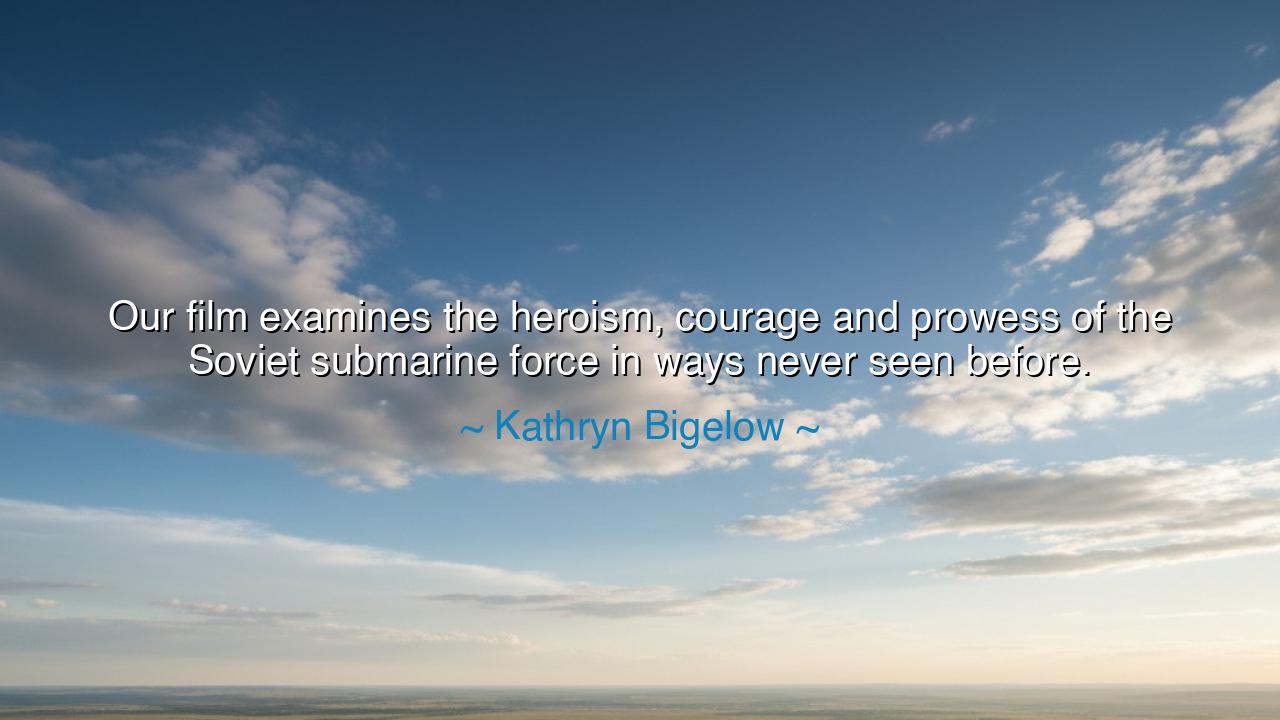
Our film examines the heroism, courage and prowess of the Soviet
Our film examines the heroism, courage and prowess of the Soviet submarine force in ways never seen before.






The visionary filmmaker Kathryn Bigelow, known for her fearless explorations of human strength under pressure, once said: “Our film examines the heroism, courage and prowess of the Soviet submarine force in ways never seen before.” In these words lies not merely the description of a work of cinema, but a reflection on the deeper nature of heroism, the complexity of courage, and the universal longing to honor those who face the abyss in silence. Bigelow’s statement transcends the boundaries of film — it becomes a meditation on what it means to confront fear, isolation, and duty in the unseen depths of human endeavor.
The origin of this quote reaches into Bigelow’s commitment to depict the hidden aspects of warfare — not as glorification, but as revelation. Her words refer to her film K-19: The Widowmaker, which tells the story of a Soviet submarine crew facing catastrophe beneath the frozen Arctic waters during the Cold War. But beyond this particular work, her statement captures a broader artistic mission: to show that courage is not bound by nationality or ideology, but is a universal human truth. Bigelow, an American director examining the valor of Soviet sailors, understood that bravery has no flag — only faces, voices, and hearts that refuse to yield when death draws near.
When she speaks of exploring heroism “in ways never seen before,” she calls upon the storyteller’s sacred duty — to uncover truth where others see only myth. The Soviet submarine force, long veiled in secrecy and suspicion, was often depicted through the lens of politics, not humanity. Yet Bigelow sought to pierce through that surface, to reveal the men within — their fears, their faith, their quiet endurance. In this, she follows in the footsteps of the ancients, who believed that true art does not invent heroism; it reveals it. Like Homer singing of Achilles’ torment, or Tolstoy writing of soldiers at Borodino, Bigelow sought to show that the greatest battles are not fought against enemies, but against despair itself.
The story of the real K-19 submarine embodies the truth of her words. In 1961, deep beneath the Arctic Sea, a nuclear reactor aboard the Soviet vessel began to fail. Radiation threatened to destroy not only the ship but to spark a global catastrophe. Knowing the danger, the crew volunteered to enter the reactor chamber, one by one, to repair it — each man fully aware that he was walking to his death. They did so not for glory, but for duty, for the safety of the world, and for each other. Within days, many were dead; within weeks, more followed. Yet through their sacrifice, they saved not only their comrades but perhaps millions of lives above the waves. It is this kind of heroism — quiet, unsung, and bound by brotherhood — that Bigelow sought to honor.
Such courage, as Bigelow reminds us, is not confined to any nation or age. It is the same spirit that guided the Spartan warriors at Thermopylae, the nurses who tended to the dying during the Black Plague, and the astronauts who stepped into the uncharted void of space. It is the courage that exists where no one can see — in the dark, in isolation, when no audience is watching. The prowess she speaks of is not mere technical skill or military strength; it is the mastery of fear, the discipline of the soul that allows a person to act rightly even when hope is lost. True prowess is not in conquering others, but in conquering oneself.
Bigelow’s insight also reveals a truth about storytelling itself. To portray courage truthfully, one must approach it with humility — with the recognition that every act of bravery is born from a heart that trembles. In her exploration of the Soviet sailors, she chose empathy over judgment, authenticity over spectacle. She reminds us that history is not divided into heroes and villains, but into those who dare and those who shrink away. The camera, like the pen or the brush, becomes a vessel of remembrance — preserving not just the events, but the spirit of those who lived them.
From this reflection, let every listener draw a lesson: honor courage wherever it is found. Do not limit your admiration to those who share your beliefs, your nation, or your creed. Look instead for the universal light of bravery that shines in all people. In your own life, remember that courage is not always dramatic. Sometimes it is the decision to persevere in quiet work, to tell the truth, to endure hardship without recognition. Let heroism be your standard not in words, but in deeds — and let prowess mean the strength to remain steadfast in your convictions when the world grows cold around you.
Thus, Kathryn Bigelow’s words endure beyond the screen. They remind us that courage is the great equalizer, transcending borders and ideologies. Whether beneath the ocean, upon the battlefield, or within the silent depths of the human heart, the call to bravery is the same. To live with courage is to live with purpose; to recognize it in others is to honor the shared soul of humanity. So may we, like those sailors beneath the Arctic ice, face our own depths with steadfast hearts — for in every act of courage, seen or unseen, the spirit of humankind rises once more toward the light.






AAdministratorAdministrator
Welcome, honored guests. Please leave a comment, we will respond soon